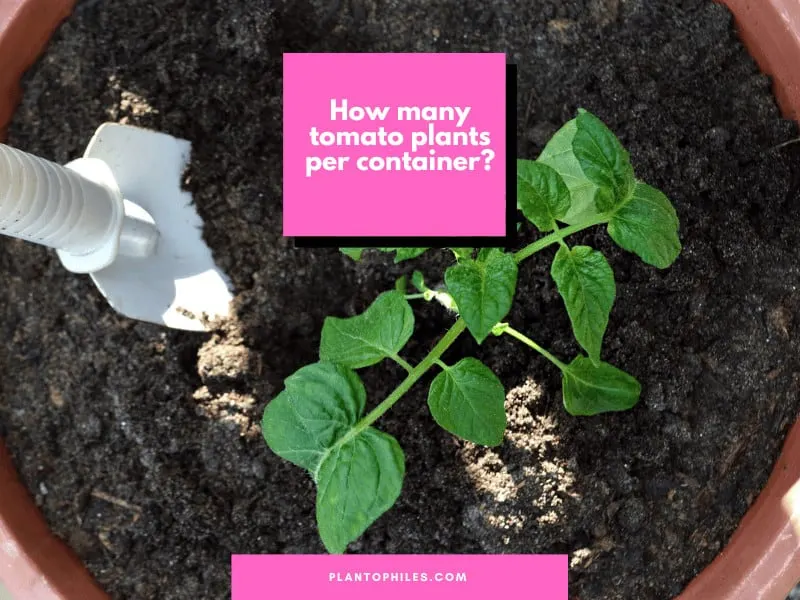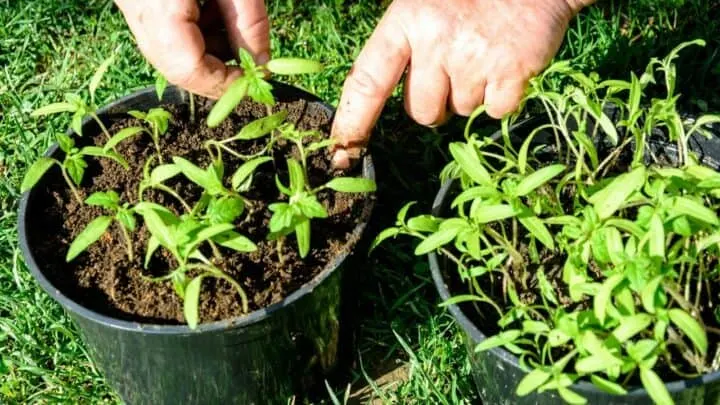How many tomato plants should I plant per container? You waste a lot of space if you only plant very few tomatoes per container. On the other hand, if you plant too many tomatoes, you are overcrowding the space and reducing the tomato harvest.
A further issue of too many tomato plants planted too close to each other is diseases.
While tomato blight is an issue often beyond your control that can affect your tomatoes negatively, there are some further problems related to planting too many tomatoes in a narrow space.
These include using a too-small container, waterlogging, and overcrowding in general. Let’s look into the first topic.
When I started planting tomatoes, I asked myself the question of how many tomato plants I should plant per container.
Table of Contents
How many tomato plants per container?
Plant one tomato per 1-2 gallon container (5 to 10-liter bucket). If using a larger container, you can plant several tomatoes. Keep tomatoes 18 to 24 inches apart (45-61cm). Each row should be 36 inches apart (91 cm).

Factors that Determine How Many Tomato Plants to Plant Per Container
1. Tomato Plant Type
Indeterminate Species
These types of tomatoes grow wildly tall. They occupy a large space as the stem grows and spreads outward indefinitely.
An excellent example of this kind includes the big beef, Sun gold, and Brandywine. They require staking for additional support.
Thus, they are not commended for container type of planting. However, you may luckily find success by growing a single plant in a 5-liter container.
Determinate tomatoes
They are also known as bush tomatoes. Their maximum height is about 4 feet or 48 inches (1.2m), and stops growing after most fruits ripen.
They do not require caging or stalking and grow ideally in a container of at least 5 gallons.
Excellent example of this species includes Roma, Taxi, and Southern Nights.
Planting a single tomato of this species in a container of 5 liters is recommended.
Dwarf tomatoes
These types of tomatoes are best suited for hanging baskets or containers. They grow to a height of 36 inches (91 cm).
The fruits are generally of different colors. With this type, you can use a smaller container and still get the total result.
In other words, it is possible to grow two tomatoes of this species in a 5-gallon container (19 liters). However, it should have a larger surface for ample spacing.
Usually, planting these tomatoes 8 to 12 inches away from each other would be best. Enough soil is also recommended as a single draft tomato requires 2.5 bags of soil.
2. Container Size
While some tomatoes of dwarf species can do well in small containers, it is essential to avoid using them.
Bigger containers of about 5 gallons (19 liters) are preferred as they hold enough soil to provide the nutrients the tomato plant needs.
If your container is the size of a large trough, you can plant more than one plant. However, strictly follow the tomato spacing guidelines for better results.
Common Mistakes to Avoid While Growing A Container
1. Excess watering
Regular watering is recommended to achieve the necessary moisture. However, it would help if you avoid excess watering to prevent drowning in the plants.
Inconsistent watering can cause end rot, split tomatoes, and overall stressed plants.
When watering, ensure your soil is moist, not soaking wet. That is your goal when watering your tomato plants.
2. Overcrowding
Tomato plants require enough space to get enough nutrients from the soil and have enough room for root expansion.
However, sometimes one might try to maximize the space by planting several tomatoes in a container, forgetting that there are higher risks than benefits.
You can still get a lot of produce with a single well-maintained plant. Avoid overcrowding by planting one plant in a container for better results.
3. Lack of sunlight
Sunlight’s crucial for the growth of tomatoes. Tomatoes need sun for photosynthesis, among others.
Ensure your tomatoes receive about 8 hours of sun daily. Since they are in a container, it is easy to forget and move them from the shade.
However, please check them throughout the day to ensure they are in a position where they are receiving maximum light.
4. Lack of fertilizers
While they can get nutrients from the soil, some soils are not rich in all nutrients and require a boost.
It is essential to add organic fertilizers in intervals of about two weeks. Use fertilizers that combine potassium, nitrogen, and phosphorus, which are all in equal ratios.
Five Tips for Successfully Growing Tomatoes in A Container
1. Use large containers
If you want to grow tomatoes in a container, it is essential to consider using a large one with proper drainage.
Most tomato varieties require a large surface for expansion.
A 5-gallon container with a large surface area is recommended for single planting of determinate and indeterminate species. However, in the case of dwarf species, you can plant two tomatoes.
The purpose of a large container is to ensure the plant gets enough nutrients and water without competing. This is necessary for healthy growth.
2. Deep planting
Dig deep into the container and place the tomato plant inside.
This ensures that when the tomato produces roots, it will support the plant that will bear numerous fruits.
If planted shallowly, it will likely fall off due to being overweighed after the plant grows tall and bears fruit. Thus, you can read about tying up tomato plants to address this issue.
3. Consistent watering
Water in a container can dry very fast; therefore, maintaining the required moisture for the healthy growth of tomatoes can be challenging.
If the soil drains fast, it is essential to have a consistent watering schedule.
Dry soil can cause the plant to wilt and even develop blossom end rot. While watering, direct water to the soil to prevent contact with foliage.
Wet foliage encourages fungus and tomato blight.
Also, ensure the soil is moist and not soggy. If the soil’s waterlogged, it can lead to the tomato plant’s roots to start rotting. Thus, ensure the container has suitable drainage holes.
4. Feed the tomatoes
Tomatoes require a wide variety of nutrients for higher productivity. They need feeding every two weeks with nitrogen, phosphorous, and potassium.
While some potting soil contains these nutrients, it is essential to confirm before applying additional fertilizers.
5. Sunlight
Tomatoes require enough sun for maximum output. About 6 to 8 hours of sun daily can be enough.
If you are growing your tomatoes inside, it is essential to take them out in the morning after sunrise and allow them to receive about 8 hours of sunlight. Learn more about these light levels by reading about them on our website.
However, avoid the excess sun for young plants as it can kill them.
Also, tomatoes do well in warm temperatures of about 60 to 80 degrees Fahrenheit (16-27 degrees Celsius). Temperatures below 50 degrees Fahrenheit (10 degrees Celsius) and above 90 degrees Fahrenheit (32 degrees Celsius) are not recommended.
Frequently Asked Questions
Why is tomato spacing important?
When tomatoes are planted together too close, they receive insufficient sunlight and grow weaker because they compete for nutrients. Pests and diseases can also transfer from one plant to another other easier.
How big should a container be for a tomato plant?
Use a container with a diameter of 18-24 inches for tomatoes. Indeterminate tomatoes will need a larger container.
How deep should a container for tomatoes be?
Containers for tomatoes should be at least 12 inches deep.
How far apart should I plant tomatoes in a container?
Plant tomatoes 18-24 inches apart (45-61cm).
Takeaways
How many tomatoes to plant in a container:
- Plant one tomato per 1-2 gallon container (5 to 10-liter bucket)
- Keep tomatoes 18 to 24 inches apart (45-61cm)
- Each row should be 36 inches apart (91 cm)

Daniel has been a plant enthusiast for over 20 years. He owns hundreds of houseplants and prepares for the chili growing seasons yearly with great anticipation. His favorite plants are plant species in the Araceae family, such as Monstera, Philodendron, and Anthurium. He also loves gardening and is growing hot peppers, tomatoes, and many more vegetables.


